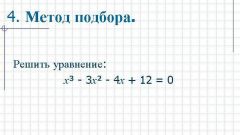Instruction
1
Theorem. States that if the polynomial P(x) divided by the binomials (x-a), where a is some number, then the remainder of such division will be P(a) is the numerical result of the substitution of a into the original polynomial P(x).
2
A root of a polynomial is a number, by substituting in the polynomial which is obtained is zero. So, if a is a root of the polynomial P(x), then P(x) is divided by the binomials (x-a) without a remainder, because P(a) = 0. But if the polynomial is divided by (x-a) with no remainder, then it can be factorize in the form:
P(x) = k · (x-a), where k is some coefficient.
P(x) = k · (x-a), where k is some coefficient.
3
If you find two roots of the quadratic equation, x1 and x2, it will decompose them as:
A · x2 + B · x + C = A · (x-x1) · (x-x2).
A · x2 + B · x + C = A · (x-x1) · (x-x2).
4
For finding roots of a quadratic equation it is important to remember the generic formula:
x(1,2) = [-B +/- √(B^2 - 4 · A · C)] / 2 · A.
x(1,2) = [-B +/- √(B^2 - 4 · A · C)] / 2 · A.
5
If the expression (B^2 - 4 · A · C), called the discriminant, is greater than zero, then the polynomial has two distinct roots x1 and x2. If the discriminant (B^2 - 4 · A · C) = 0, the polynomial has one root of multiplicity two. In fact, it has the same two real roots but they are the same. Then decompose the polynomial as:
A · x2 + B · x + C = A · (x-x0) · (x-x0) = A · (x-x0)^2.
A · x2 + B · x + C = A · (x-x0) · (x-x0) = A · (x-x0)^2.
6
If the discriminant is less than zero, i.e. the polynomial has no real roots, then to factorize a polynomial of impossible.
7
To find the square roots of the polynomial, you can use not only formula, but also the vieta theorem:
x1 + x2 = -B,
x1 · x2 = C.
Vieta theorem says that the sum of the square roots of the trinomial is equal to the coefficient of x, taken with the opposite sign, and the product of the roots is equal to the free factor.
x1 + x2 = -B,
x1 · x2 = C.
Vieta theorem says that the sum of the square roots of the trinomial is equal to the coefficient of x, taken with the opposite sign, and the product of the roots is equal to the free factor.
8
To find the roots not only have a square of a polynomial, but biquadratic. Biquadratic polynomial is called a polynomial of the form A · x^4 + B · x^2 + C. Replace in the given polynomial x^2 for y. Then you get a square trinomial, which, again, you can factorize:
A · x^4 + B · x^2 + C = A · y^2 + B · y + C = A · (y-y1) · (y-y2).
A · x^4 + B · x^2 + C = A · y^2 + B · y + C = A · (y-y1) · (y-y2).






